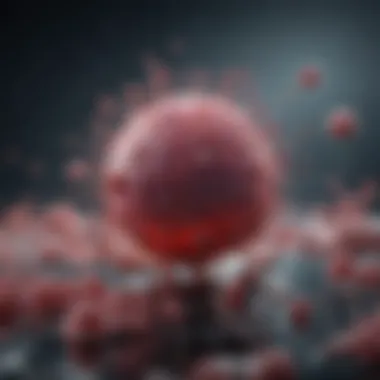Interleukin 17: Immune Regulation and Disease Impact


Intro
Interleukin 17 (IL-17) has emerged as a significant player in the realm of immunology. This pro-inflammatory cytokine isn't merely a bystander; it's deeply entrenched in the body's immune responses. Understanding its complexities provides insight not just into immunological functions but also into a myriad of diseases linked to aberrant immune activities. From autoimmune conditions to infectious diseases, IL-17 is often front and center, prompting researchers to delve into its expanses with an eye toward therapeutic implications.
Research Overview
The journey of IL-17 research began with its discovery in the 1990s, but it has since exploded into an intricate field of study. As scientists probe deeper, they uncover the nuanced roles IL-17 plays in coordinating immune responses. Various methodological approaches have been vital in elucidating these roles.
Methodological Approaches
- In Vivo Studies: Animal models, especially mice, allow researchers to observe the direct effects of IL-17 modulation on immune responses and related pathologies.
- In Vitro Experiments: Cell culture methods provide a controlled environment to examine how IL-17 interacts with different immune cells. Here, scientists can pinpoint signaling pathways without the noise of in vivo complexities.
- Clinical Trials: As the interest in targeting IL-17 for therapeutic purposes grows, clinical trials have started to spring up, testing various IL-17 inhibitors across multiple disease spectrums.
Moving on to the significance and implications of IL-17 research, the findings have been nothing short of revolutionary.
Significance and Implications
The implications of IL-17 in both understanding and treating diseases are enormous:
- Autoimmune Disorders: Diseases like rheumatoid arthritis and psoriasis show a clear connection with IL-17 concentrations.
- Allergy Responses: Elevated levels of IL-17 have been implicated in asthma and allergic reactions.
- Infectious Diseases: IL-17's role in fighting off certain pathogens showcases its importance in infectious processes.
"The findings surrounding IL-17 reoriente the way we think about treatment strategies. Instead of just dampening the overactive immune response, we can begin to tailor therapies that specifically modulate IL-17 pathways."
By thoroughly mapping these implications, researchers are setting a course for treatments that may not just alleviate symptoms, but also address root causes embedded in the immune responses.
Current Trends in Science
The landscape of IL-17 research is continually evolving, driven by the innovative techniques and tools emerging from scientific advancements. Staying ahead in this field requires an understanding of the innovative techniques and tools currently utilized.
Innovative Techniques and Tools
Modern techniques such as gene editing (e.g., CRISPR) and advanced imaging technologies enable a close-up view of IL-17 activity and interactions in real-time. These innovations spark new hypotheses and steers experimental inquiries toward unexplored territories.
Interdisciplinary Connections
Additionally, IL-17 research draws connections across various fields, including:
- Molecular Biology: Dissecting IL-17's signaling pathways at the molecular level opens doors for tailored therapeutic interventions.
- Genetics: Understanding genetic pre-dispositions towards IL-17 related conditions can lead to personalized medicine.
- Pharmaceutical Sciences: The development of novel IL-17 inhibitors is a testament to the busy intersection of biology and pharmacology.
The intertwining of these disciplines propels the research into uncharted territories, emphasizing the importance of a comprehensive approach in understanding IL-17’s roles.
In summation, delving into the intricacies of IL-17 reveals far-reaching implications that can transform how we address various immune-mediated conditions. As more studies surface, shedding light on its biological functions, the potential for clinical applications becomes even more promising.
Prelude to Interleukin
Interleukin 17, or IL-17, is becoming a linchpin in our understanding of immune regulation. As an inflammatory cytokine, IL-17 is not just another player on the stage; it’s a major architect in how our immune response unfolds, especially in the context of various diseases. Understanding IL-17 is akin to unlocking a treasure chest of therapeutic opportunities and disease mechanisms, ultimately guiding us in combating a wide array of conditions from autoimmune diseases to cancers.
Definition and Discovery
IL-17 was first identified in the late 1990s, with its roles highlighted vividly in the context of autoimmune diseases. Initially, researchers found it produced by a subset of T cells, paving the way for its classification as a key pro-inflammatory cytokine. Notably, IL-17 not only helps in fighting infections but also has been implicated in excessive inflammatory responses that can lead to tissue damage.
Classification of IL-17 Family
The IL-17 family comprises several cytokines, each with unique characteristics and implications. Understanding these distinctions is crucial for grasping the full scope of IL-17’s impact on health and disease.
IL-17A
IL-17A is arguably the most studied member of the IL-17 family. It is a significant player in mediating inflammation and is often the catalyst in autoimmune responses. What sets IL-17A apart is its ability to recruit neutrophils, which are the body’s first responders during infections. This recruitment is critical; however, excessive activity can lead to chronic inflammation, seen in conditions like psoriasis and rheumatoid arthritis. IL-17A’s ease of being targeted with specific inhibitors like secukinumab brings a promise for effective treatment strategies.
IL-17F
IL-17F, while similar to IL-17A, exhibits a somewhat nuanced role. Its expression often occurs alongside IL-17A and they can work in tandem to amplify the immune response. A defining feature of IL-17F is its comparatively lower pro-inflammatory activity, which can offer protective benefits in certain contexts—potentially softening the intensity of excessive immune reactions. However, its interactions and potential roles in disease still require deeper exploration, making it an interesting subject within the IL-17 family.
Other IL-17 Family Members
In addition to IL-17A and IL-17F, the family includes other members like IL-17B, IL-17C, IL-17D, and IL-17E. Each of these cytokines has its own unique signaling pathways and biological effects. For instance, IL-17C has been associated with mucosal immunity and plays a role in protecting against pathogenic organisms. Understanding these lesser-known cytokines is essential, as they might contribute to the immune response in ways we have yet to fully appreciate. Their diverse functionalities highlight the complexity of the immune system and underscore the need for continued research.
Biological Functions of IL-17
The biological functions of Interleukin 17 (IL-17) are fundamental to understanding how this cytokine orchestrates the immune response. IL-17 is not just a one-trick pony; it is integral in enhancing the body's defense mechanisms against numerous pathogens while simultaneously playing a part in the pathology of various diseases. By delving into the details of its role, we gain insights into therapeutic strategies that may mitigate immune-related disorders.
Role in Immune Response
Cytokine Production
Cytokine production initiated by IL-17 is a key element in the body's immune response. This pro-inflammatory cytokine prompts various immune cells to produce additional cytokines, notably TNF-α, IL-6, and IL-1β. These cytokines further amplify the immune response by attracting more immune cells to the site of infection or inflammation. A hallmark of cytokine production is its ability to create a feedback loop, enhancing the immune system's response to threats.
What makes cytokine production significant here is its versatility: it can be tailored depending on the type of immune response needed. When looking at diseases with chronic inflammation, the presence of heightened cytokine production often indicates an exacerbated defensive state, which, in certain situations, can be counterproductive, leading to damage to healthy tissues. This dual nature of the cytokine response underscores its complexity and importance in the overall immune strategy.


Cell Recruitment
IL-17 also plays a pivotal role in cell recruitment, acting like a beacon for circulating immune cells. It promotes the movement of neutrophils, monocytes, and other leukocytes to the sites needing attention. This recruitment mechanism is vital, especially in the context of infections where a rapid influx of immune cells can determine the outcome of the battle against the invading microorganisms.
The unique feature of cell recruitment via IL-17 is its selective nature, primarily targeting those immune cells that are most useful for combating specific pathogens. However, this targeted action does come with a downside; excessive or incorrect recruitment can lead to inflammatory diseases like asthma or rheumatoid arthritis. Understanding this balance is crucial in developing therapies that can modulate IL-17 without entirely inhibiting its beneficial effects.
Role in Neutrophil Activation
Neutrophil activation is another significant aspect of IL-17's functions. This cytokine is well-known for its ability to energize neutrophils, the first responders in inflammatory processes. By enhancing their motility, phagocytic capabilities, and production of reactive oxygen species, IL-17 ensures that these cells are on high alert when pathogens are present.
The key characteristic here is that neutrophils can be viewed as the heavy artillery in the immune arsenal, and IL-17 is essentially the commander giving them the order to engage. While this command is generally beneficial, excessive neutrophil activation can lead to tissue damage, illustrating the fine line IL-17 treads between efficacy and pathology in immune regulation.
Influence on Adaptive Immunity
As we shift focus to adaptive immunity, IL-17's influence extends beyond innate responses to the more nuanced realm of T and B cell activity. Here, it plays a critical role in shaping adaptive immune responses that effectively target specific pathogens.
T Helper Cell Differentiation
IL-17 is indispensable for T-helper cell differentiation, particularly in guiding naïve T cells toward becoming T7 cells. These specialized cells are crucial in orchestrating the immune response against extracellular pathogens, especially fungi and bacteria. Their differentiation process is primarily induced by the presence of IL-6 and TGF-β, allowing the immune system to mount a tailored defense strategy.
The appeal of T-helper cell differentiation is its ability to enhance a nuanced immune response. Once activated, T7 cells can produce even more IL-17, sustaining the immune response. However, this mechanism has its downsides; dysregulation in T7 cell differentiation can contribute to autoimmune diseases such as lupus or multiple sclerosis, making it imperative to understand how IL-17 affects this balance.
Impact on B Cells
Finally, the impact on B cells cannot be overlooked. IL-17 significantly influences B cell activation and maturation, promoting the production of antibodies. This role is especially important during infections, where a robust antibody response can neutralize pathogens before they wreak havoc.
However, one must consider the other side of the coin: exaggerated IL-17 activity may lead to unwanted autoantibody production, further complicating autoimmune conditions. Thus, while IL-17 is beneficial for B cell functionality, there’s a pressing need to study its regulation to avoid adverse outcomes in clinical applications.
"Understanding IL-17's biological functions is not just about recognizing its immunological roles; it’s an essential step in devising potential therapies for various diseases that hinge on immune dysregulation."
In summary, the biological functions of IL-17 cover a vast landscape, from modulating cytokine production and cell recruitment to influencing adaptive immunity via T cell differentiation and B cell responses. The dual nature of its effects makes it a vital subject for exploration, particularly regarding its implications for health and disease.
IL-17 Receptors and Signaling Pathways
Interleukin 17 (IL-17) has gained prominence not just for its production but also for how it interacts through its receptors and the signaling pathways it activates. Understanding IL-17 receptors and their associated signaling cascades is crucial for grasping how IL-17 contributes to immune responses and various disease states. The receptors for IL-17, namely IL-17RA and IL-17RC, mediate the effects of this cytokine and are instrumental in initiating signal transduction that modifies cellular behavior. These dynamics help to delineate the pathways of immune regulation, underscoring both therapeutic and pathological implications.
IL-17 Receptor Structure
The structure of IL-17 receptors reflects a thoughtfully evolved mechanism for immune engagement. Primarily, IL-17 receptors comprise two main subunits, IL-17RA and IL-17RC, forming heterodimers that bind IL-17A and IL-17F. This structural arrangement is significant because it enables the selective activation of downstream signaling pathways. The extracellular domain of these receptors is notably rich in fibronectin domains, enhancing ligand binding affinity. Moreover, the presence of a conserved cytoplasmic domain facilitates the coupling of these receptors to signaling proteins, which promotes the cellular responses needed during immune challenges.
Signal Transduction Mechanisms
Diving deeper, we uncover the intricate signal transduction mechanisms activated by IL-17 receptors, which lay the groundwork for cellular outcomes, from inflammation to immune defense.
MAPK Pathways
The MAPK pathways are pivotal in transmitting signals from the IL-17 receptor to the nucleus of cells, ultimately influencing gene expression. When IL-17 binds to its receptor, it activates MAPK cascades, such as ERK, p38 MAPK, and JNK.
- Key Characteristic: The rapid activation and versatility of MAPK pathways make them a favorite in discussions about immune signaling.
- Unique Feature: One of the unique features of these pathways is the ability to cross-talk with other signaling mechanisms, enabling a fine-tuning of responses to cytokine stimulation.
- Advantages: Their ability to respond quickly to IL-17 ensures that immune cells can rapidly mount an appropriate reaction according to the context, whether it’s fighting off pathogens or sustaining chronic inflammation.
- Disadvantages: However, this rapid response mechanism can sometimes lead to dysregulated inflammation, contributing to autoimmune conditions, making the balance both crucial and precarious.
NF-κB Activation
The NF-κB pathway represents a cornerstone of IL-17's signaling landscape. Upon IL-17 receptor activation, the recruitment of TRAF6 leads to the activation of the IKK complex, which ultimately releases NF-κB dimers such as p65/p50.
- Key Characteristic: NF-κB is known for its role in regulating genes associated with inflammation and immune response, making it a crucial player in this context.
- Unique Feature: Its ability to remain sequestered in the cytoplasm until it's needed allows for a quick mobilization during inflammatory responses.
- Advantages: This makes NF-κB an efficient pathway to amplify the response to IL-17, promoting the expression of numerous pro-inflammatory cytokines and chemokines that facilitate immune recruitment.
- Disadvantages: On the flip side, excessive or prolonged activation of NF-κB can escalate inflammatory diseases, reinforcing its dual role in both promoting immunity and fostering chronic inflammatory conditions.
Crosstalk with Other Cytokines
Crosstalk between IL-17 pathways and those of other cytokines reveals a complex web of immune regulation. Through interactions with various cytokines like IL-6, IL-1, and TNF-α, IL-17 helps to coordinate a diverse immune response. This interplay can either synergize or antagonize effects, heavily influencing disease pathogenesis and progression.
Understanding the interconnections between IL-17 receptors, the signaling mechanisms, and the involvement of other cytokines offers great promise for therapeutic advancements, especially in treating autoimmune diseases and managing immune responses more effectively.
Role of IL-17 in Autoimmune Diseases
Interleukin 17 (IL-17) holds a prominent position in the landscape of autoimmune diseases. These diseases, characterized by the immune system's misdirection against the body's own tissues, have been linked intricately to the pro-inflammatory pathways mediated by IL-17. Clearly, IL-17's role as a cytokine not only promotes inflammation but also drives the disease process across various syndromes. Understanding this connection is crucial for any immunologist or clinician dealing with such pathological states.
The activation of IL-17 leads to a cascade of immune responses that can exacerbate tissue damage and inflammation. Importantly, each autoimmune condition can have unique nuances in IL-17's behavior and effects, which we will delve into below.
Psoriasis
Psoriasis is an autoimmune skin condition where IL-17 is a significant player. This cytokine is highly involved in the pathogenesis of psoriasis, leading to the rapid turnover of skin cells resulting in thick, scaly patches on the skin. Elevated levels of IL-17A and IL-17F in affected skin suggest that these cytokines manage not just inflammation but also keratinocyte proliferation and differentiation.
The mRNA expression of IL-17A in lesions correlates with disease severity, supporting the hypothesis that targeting IL-17 could offer therapeutic benefits. Several IL-17 inhibitors have emerged, showing promise in reducing the symptoms in patients, thereby attesting to the pivotal role this cytokine plays in psoriasis. Thus, recognizing IL-17’s involvement offers both insights into disease mechanisms and pathways for targeted therapies.
Rheumatoid Arthritis
In rheumatoid arthritis (RA), IL-17 is implicated in driving the inflammatory process within the joints. This cytokine contributes to bone erosions and cartilage degradation through the recruitment of neutrophils and activation of synovial fibroblasts.


"The increased production of IL-17 in the synovial fluid of RA patients highlights its relevance in joint inflammation."
The interaction between IL-17 and other cytokines, such as TNF-alpha, complicates the clinical picture but illustrates the potential for combination therapies aiming at different points in the inflammatory pathway. Recent studies indicate that therapies targeting IL-17 can not only alleviate symptoms but also slow down the radiographic progression of joint damage, marking a significant step in managing this chronic disease.
Multiple Sclerosis
Multiple Sclerosis (MS) is another autoimmune attack where IL-17 has drawn considerable interest. In MS, the immune system targets the myelin sheath around nerve fibers, leading to debilitating neurological symptoms. Studies suggest that IL-17-producing cells may be instrumental in the development and progression of this condition, particularly in its relapsing forms.
Research emphasizes that T7 cells, which produce IL-17, are present in the cerebrospinal fluid of MS patients. This underscores the potential of IL-17 as a biomarker for disease activity, further enhancing the clinical approach to managing MS. While treatments are advancing, the role of IL-17 in MS poses both challenges and opportunities for pharmaceutical interventions aimed at rebalancing the immune response.
In summation, the contribution of IL-17 to autoimmune diseases such as psoriasis, rheumatoid arthritis, and multiple sclerosis is evident. The heightened understanding of this cytokine's influence allows for more targeted therapeutic strategies, which may significantly improve patient outcomes in the future.
IL-17 in Infectious Diseases
Interleukin 17 (IL-17) plays a significant role in the immune response against various infectious diseases. Its presence in both innate and adaptive immunity indicates a versatile function in host defense mechanisms. These roles vary depending on the type of pathogen and the environment in which it operates. It’s necessary to highlight that IL-17 is not just a passive player; it actively shapes the immune landscape, influencing the outcomes of infections and potentially altering disease trajectories. Understanding IL-17’s implications in infectious diseases is vital for developing therapeutic strategies and vaccines.
Role in Bacterial Infections
Bacterial infections often elicit robust immune responses, with IL-17 producing cells like T7 cells being on the front lines. These cells contribute significantly to the defense against a range of bacteria, particularly extracellular pathogens. For instance, during a staphylococcal infection, IL-17 can recruit neutrophils to the site of infection, enhancing phagocytosis and bacterial clearance. This recruitment is essential as neutrophils are often the first responders in such infections.
Moreover, IL-17 enhances the production of other pro-inflammatory cytokines, like TNF-α and IL-6. These cytokines set the stage for a coordinated immune response against bacteria, collaborating with the innate immune system. However, the double-edged sword nature of IL-17 should not be overlooked. In some chronic bacterial infections, excessive IL-17 production might result in tissue damage and contribute to inflammatory diseases.
- Key Points to Remember:
- IL-17 aids in neutrophil recruitment during bacterial infections.
- It works alongside other cytokines to mount an effective immune response.
- Excessive IL-17 can lead to tissue damage and chronic inflammation.
Influence on Fungal Pathogens
Moving onto the realm of fungal pathogens, IL-17 signaling plays a critical part in combating infections like candidiasis. Fungi present unique challenges to the immune system, requiring a specific type of response where IL-17 is particularly valuable. In the context of infections like those caused by Candida albicans, IL-17 has been shown to stimulate epithelial cells to produce antimicrobial peptides, which are crucial for controlling fungal growth.
Furthermore, the relationship between IL-17 and antifungal defense is underscored by its role in recruiting additional immune components, such as macrophages and dendritic cells. This amplification of the immune response can be the difference between a successful resolution of infection and a persistent, systemic issue. In immunocompromised patients, the malfunction of IL-17 pathways can lead to increased susceptibility to fungal infections, presenting a unique challenge in managing such cases.
- Considerations When Examining IL-17 in Fungal Infections:
- IL-17 promotes the production of antimicrobial peptides crucial against fungal growth.
- Recruits immune cells to strengthen the antifungal response.
- The dysfunction of IL-17 pathways may lead to increased vulnerability in immunocompromised individuals.
In summary, the exploration of IL-17 in infectious diseases highlights its critical role as a mediator of immune responses while also serving as a cautionary tale about the potential for excessive responses leading to pathology.
Understanding these dynamics is essential for both basic research and clinical approaches aimed at manipulating IL-17 for therapeutic benefits in various infectious contexts.
Implications of IL-17 in Cancer Biology
Interleukin 17, commonly referred to as IL-17, has recently become a focal point in oncology, as it straddles two seemingly opposite roles in both promoting and inhibiting tumorigenesis. Understanding its implications in cancer biology is crucial as it guides therapeutic strategies and deepens our comprehension of tumor microenvironments.
Tumor Microenvironment
IL-17 significantly shapes the tumor microenvironment (TME) by influencing various cellular components such as immune cells, stromal cells, and even the extracellular matrix. This cytokine can attract neutrophils and other immune cells to tumor sites.
The influx of these cells can have dual results:
- Tumor Suppression: Neutrophils can mediate anti-tumor responses by enhancing the activity of cytotoxic T cells.
- Tumor Promotion: Conversely, the same neutrophils may produce reactive oxygen species and cytokines that foster a pro-tumorigenic environment.
This fine balance is essential. In certain contexts, IL-17 can modulate the production of other cytokines, promoting angiogenesis and the survival of cancer cells. The ability of IL-17 to either suppress or promote tumor growth is largely dependent on the type of tumor and the specific microenvironment, making this area ripe for exploration. Recent studies hint at a correlation between high IL-17 levels and poor prognosis in various cancers, suggesting that targeting IL-17 pathways might provide therapeutic avenues.
IL-17 as a Double-Edged Sword
The characterization of IL-17 as a double-edged sword reveals its complex nature in oncology. On one hand, many studies indicate that IL-17 plays a role in anti-tumor immunity, serving to bolster the immune response against isha tumor cells. For instance:
- IL-17 aids in the recruitment of T cells, which are pivotal in attacking cancer cells.
- It has been observed that IL-17 can help in the maturation of dendritic cells, further enhancing the anti-tumor response.
On the other hand, the same mechanisms can contribute to tumor progression. For example:
- Elevated IL-17 levels may correlate with worse outcomes in certain cancers like melanoma and colon cancer.
- In these circumstances, IL-17’s role in promoting inflammation could inadvertently protect tumors from immune surveillance.
"Understanding IL-17’s dual role in cancer biology presents both challenges and opportunities in therapeutic design."
The potential of IL-17 as a therapeutic target hinges on the need to decipher its complex interactions in the tumor microenvironment. Identifying specific pathways and understanding how they vary across different cancers will be critical in developing effective treatments for patients.
In summary, the implications of IL-17 in cancer biology are manifold and complex. Considering its role in modulating immune responses within the tumor microenvironment sheds light on how it can be harnessed or inhibited in the fight against cancer. As research unfolds, the duality of IL-17 must be at the forefront of discussions related to both its therapeutic promise and its challenges.
Therapeutic Targeting of IL-17
The landscape of immunotherapy has changed significantly, and therapeutic targeting of IL-17 emerges as a promising approach in the realm of disease management. IL-17 has been implicated in various inflammatory and autoimmune conditions, making it a focal point for researchers aiming to develop effective treatments. Targeting this cytokine not only offers the potential for symptom relief but also addresses the underlying pathophysiology of these diseases.
One of the most significant advantages of IL-17 inhibition is its ability to reduce inflammation swiftly and effectively. In conditions like psoriasis and rheumatoid arthritis, where IL-17 levels are often elevated, targeting this pathway can lead to improved patient outcomes. The specificity of IL-17 inhibitors helps in mitigating unwanted systemic immune responses, which can occur with broader immunosuppressive therapies.
However, the journey of therapeutic targeting is not altogether without hurdles, which brings us to the next point of discussion.
Current IL-17 Inhibitors


Current therapeutic landscapes boast several IL-17 inhibitors, each designed to address distinct facets of autoimmune diseases.
- Secukinumab (Cosentyx): This monoclonal antibody targets IL-17A directly. It's particularly noteworthy for its efficacy in treating plaque psoriasis and ankylosing spondylitis. The clinical trials have shown that it can significantly improve the quality of life for patients with chronic inflammatory diseases.
- Brodalumab (Siliq): Another IL-17A inhibitor, Brodalumab, received attention for its dual action – blocking IL-17A while also acting on the IL-17 receptor. This innovative approach can modify the immune response in profound ways.
- Ixekizumab (Taltz): Like Secukinumab, Ixekizumab targets IL-17A, but it is known for its rapid onset of action. It provides relief from symptoms in patients with moderate to severe plaque psoriasis.
The availability of these agents highlights how far cytokine-targeted therapy has come, yet it also brings forward certain issues which must be addressed.
Challenges in Targeting IL-17
Despite the promise that IL-17 inhibitors present, several challenges remain that can influence their overall effectiveness and acceptability in the clinical setting.
Specificity and Safety
The specificity and safety of IL-17 inhibitors is a significant concern. While these agents are designed to target IL-17 directly, the immune system is a finely tuned orchestra. Altering one component can lead a ripple across the entire symposium of cytokines.
- A key characteristic of IL-17 targeting is the need to strike a delicate balance. On one hand, reducing IL-17 levels can control inflammation; on the other hand, it may increase susceptibility to infections. For instance, IL-17 plays a vital role in defending against certain pathogens.
- Furthermore, the focus on specificity ensures that we are not suppressing other pathways that could be critical for maintaining a robust immune response.
Advantages of a tailored approach include fewer side effects compared to systemic immunosuppressants, but the disadvantage is that some patients may still experience severe reactions or infections due to the immune modulation.
Potential Side Effects
Potential side effects from IL-17 inhibition can vary widely among individuals. Understanding these effects is crucial in patient management. For instance, some patients might report an increase in upper respiratory infections or even a heightened risk of certain opportunistic infections.
- This characteristic makes ongoing monitoring essential during treatment.
- An emerging concern is the connection between IL-17 inhibitors and inflammatory bowel diseases. While causal relationships are still being explored, some patients have exhibited symptoms that mimic inflammatory bowel conditions after initiating therapy.
The advantage here lies in the possible rapid therapeutic effects which can drastically improve quality of life for many. The disadvantage, however, is that patients may send mixed signals regarding their treatment efficacy based on the side effects they experience.
"The balance of efficacy and safety in therapeutic targeting is vital for ensuring optimal outcomes in patient care."
Through careful monitoring and tailored approaches to individual health profiles, addressing these challenges can make therapeutic targeting of IL-17 a more viable option for many patients. This nuanced understanding of IL-17 inhibitors is essential as we move towards future applications in clinical practice.
Future Directions in IL-17 Research
As we delve into the exciting frontier of IL-17 research, it's clear that understanding the multifaceted roles of this cytokine is paramount. The increasing recognition of IL-17's involvement across various immune responses has led scientists to explore its functions beyond conventional concepts. This section highlights some key emerging areas that may shape future studies and therapeutic strategies.
Emerging Areas of Study
Interactions with Gut Microbiome
The gut microbiome holds a treasure trove of diversity, influencing nearly every aspect of health. Exploring the interactions between IL-17 and gut microbiota offers a new lens through which to view immune system modulation. Notably, IL-17 seems to play a pivotal role in maintaining gut homeostasis. It helps in promoting a balanced immune response against pathogens while preventing excessive inflammation.
Key aspects of this interaction include:
- Microbiota Composition: Specific bacterial strains may promote IL-17 production, leading to enhanced immunity against gut pathogens.
- Mucosal Immunity: IL-17's involvement could be crucial for forming effective mucosal barriers, which protects against invading pathogens.
This area of study is beneficial because it intertwines immunology with microbiology, highlighting the significance of gut health in overall immune regulation. However, there might be disadvantages as well, such as the complexity of distinguishing which microbial components contribute positively or negatively to IL-17 functions.
IL-17 in Aging
Aging is a relentless process that influences many physiological systems, and the immune system is no exception. Investigating the interplay between IL-17 and aging could provide insights into immunosenescence—the gradual decline in immune function with age. A critical characteristic of IL-17 in this context is its differential expression in older adults, often leading to dysregulated immune responses.
Key points relevant to IL-17 in aging include:
- Inflammatory State: Aging is often accompanied by increased levels of pro-inflammatory cytokines including IL-17, contributing to a systemic inflammatory state.
- Age-associated Diseases: Understanding IL-17's role may help elucidate mechanisms that drive diseases prevalent in older populations, like arthritis or certain cancers.
By researching IL-17 in aging, researchers can uncover potential pathways that may help mitigate age-related immune decline. However, the challenge remains in delineating whether IL-17 levels are a cause or a consequence of aging processes.
Translational Research Opportunities
Future research has the potential to bridge the gap between bench and bedside through translational studies focusing on IL-17. By understanding how IL-17 functioning can be modulated in clinical settings, researchers can pave the way toward innovative therapies for diverse conditions. This line of inquiry is important because it may lead to therapeutic targets that can either enhance functionality where needed or inhibit it in pathological states.
In summary, the exploration of IL-17’s interactions with the gut microbiome, its role in the aging process, and the pursuit of translational research opportunities hold significant promise. These investigations could contribute significantly to our understanding of immune regulation and disease pathogenesis, ultimately leading to the development of effective therapies.
Closure
In wrapping up the discussion on Interleukin 17, it's important to underscore how significant this cytokine is in the complex web of immune regulation and disease mechanisms. IL-17 does not operate in isolation; rather, it orchestrates a symphony of immune responses that influence both health and disease outcomes.
One of the key insights presented in this article is the multifaceted role IL-17 plays. It’s not only a pro-inflammatory agent but also a crucial player in orchestrating the adaptive immune response. As highlighted throughout the various sections, IL-17 can tip the balance between effective immune defense and harmful overreaction, making it a central focus in autoimmune conditions like psoriasis, rheumatoid arthritis, and multiple sclerosis.
Furthermore, this cytokine's involvement in infectious diseases showcases its dual function. For instance, while IL-17 promotes neutrophil activation and enhances responses to certain bacterial infections, it can also contribute to pathology in chronic inflammatory states. This sharpens the focus on the need to appreciate the nuances of IL-17’s role, rather than viewing it merely as a villain or a hero in disease.
The challenges associated with therapeutic targeting of IL-17 also demand careful consideration. While the introduction of IL-17 inhibitors into clinical practice has shown promise for managing a range of diseases, the risk of specific side effects and long-term consequences necessitates a balanced approach to their use. Better understanding of the signaling pathways and receptors involved opens pathways for improved therapies that might mitigate these risks.
In summary, a comprehensive understanding of IL-17's functions, both beneficial and detrimental, is pivotal for researchers and clinicians alike. It paves the way for advancements in personalized medicine that could better tailor treatments based on an individual's immune profile. As new research continues to unfold, staying attuned to the evolving narrative surrounding IL-17 will be crucial in harnessing its potential while mitigating associated risks.
Summary of Key Insights
- IL-17's Multifunctionality: Recognized for its role in both promoting inflammation and facilitating an effective immune response against pathogens.
- Diseases Linked to IL-17: Critical role in diseases such as psoriasis, rheumatoid arthritis, and multiple sclerosis, reflecting its importance in both autoimmune disorders and infectious conditions.
- Therapeutic Potential and Challenges: Ongoing development of IL-17 inhibitors presents opportunities and challenges, emphasizing the need for specificity and safety in targeting this cytokine.
Final Thoughts
The exploration of IL-17 provides a window into the intricate dynamics of the immune system. As researchers dive deeper into its mechanisms, it becomes increasingly evident that this cytokine is not merely a straightforward target but a complex player in immune regulation. The interplay between its protective and pathogenic roles underscores the importance of cautious optimism in therapeutic strategies. The future of immunological research will benefit from a nuanced understanding of IL-17, paving the way for innovative treatments that balance efficacy with safety.
Ultimately, while the journey into understanding IL-17 continues, the implications of these findings hold significant promise for improving patient outcomes in a variety of diseases, reshaping our approaches to immune-mediated conditions.



